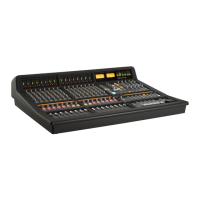Artist’s Monitoring
M
atrix has an additional output for the artist’s headphones, which is controlled by the
%'&' "!'"%
a
rea of the centre
section, to the right of the
! "!'"% controls. The six buttons on the left hand side select the signal which is feeding
the artist’s monitoring. The sources available are (from bottom to top) the + bus, the control room monitor output ( "!),
the ( bus, the desk’s ' external monitor input (see Page 44), and the first of the two analogue external monitor inputs
(+'). Each button lights to indicate which is active.
Note that while the other buttons light yellow, the "! bus lights green in keeping with its colour coding.
Normally these buttons cancel each other. However, the summing button (
S
) located immediately above the five source selector
buttons, removes the intercancelling feature and instead sums all selected inputs, enabling multiple sources to be monitored
simultaneously. Deselecting the
S
button cancels all monitoring sources and returns the artist’s monitor to intercancelling mode.
The %'&' "!'"% has available a 2-band EQ with high-pass and low-pass shelving controls
and Total Recall LEDs. This is located in the top right of the %'&' "!'"% area, and can
be switched into the circuit by pressing the $ button located in between the and pots.
Both EQ pots are indented in the centre.
The pot in the bottom right is a gain control for the artist monitor output. The "!" button
above it reduces the feed to mono.
Engineer’s Headphones
There is an engineer’s headphone output located in the trim on the right hand side of Matrix, close
to the large navigation wheel. It is controlled by the area above the transport counter, consisting
of a #"! gain pot and a %" %'&' button which switches the headphone feed
from the control room monitor mix to the artist’s monitor mix (see above). The button lights to
indicate that the feed has been switched to the artist’s mix.
While the %" %'&' button is not selected, the headphone signal follows the source
selection in the ! "!'"% area, along with the H and "!" buttons, but is not
affected by the , (', ! or level controls.
Conversely, when %" %'&' is selected, the engineer’s headphone signal follows the %'&' "!'"% source
selection, $ insert and "!" button, but is not affected by the level control.
Talkback
The engineer can talk to the artist by pressing and holding the %'&' button located to the left of the large
navigation wheel in the centre section. This sends the signal from the desk’s inbuilt talkback microphone to the
artist’s monitor feed.
The talkback microphone is located above the
! "!'"% area of the centre section
(shown right). Its level is set by the ' gain trim immediately above it. When it is pressed, the
function is automatically activated in the main monitoring.
The action of the talkback switch may be changed from momentary to latching by engaging the
“
'0B27” switch within the && >="?B menu.
Note that the talkback function can also be assigned one of the two rear panel foot switch inputs via the * tab in the
Matrix Remote. See Page 104 for more details.
Note also that the talkback does not feed the engineer’s headphone signal, even when the %" %'&' button has
been selected.

